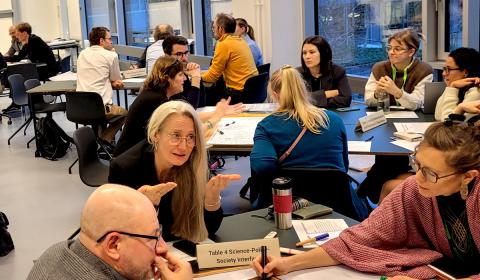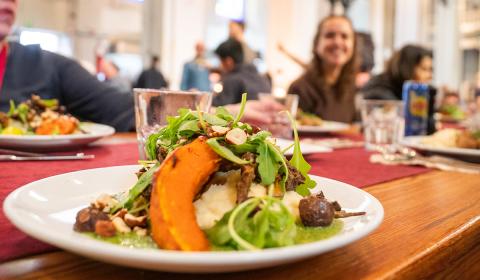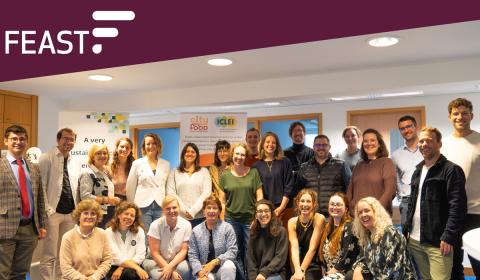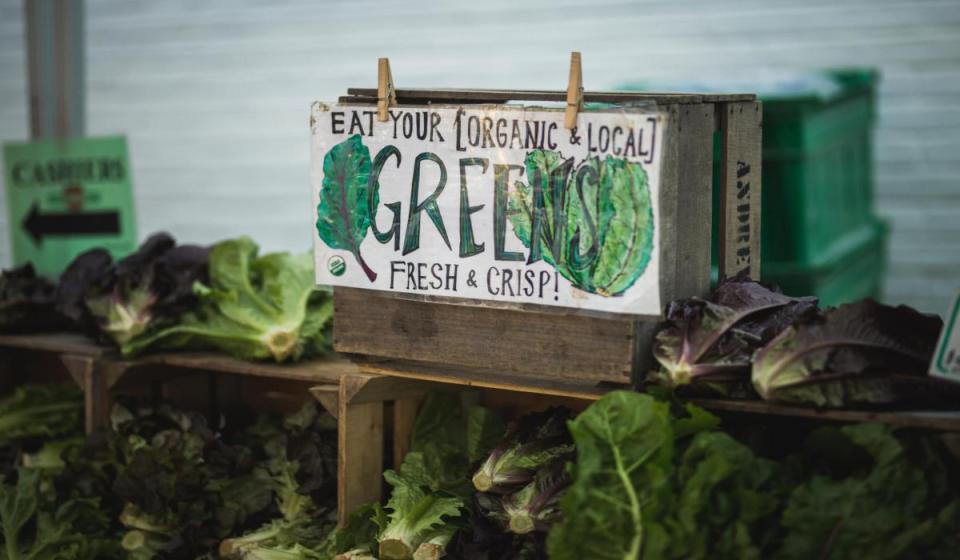
Image source: Photo by Dan DeAlmeida on Unsplash
When examining agriculture, it's imperative to adopt a comprehensive perspective that encompasses not only science and technology but also its intersections with politics, economics, and policies. In this blog post, we will explore the complexities of organic farming within the European Union (EU) since 2012, acknowledging both its potential benefits and challenges. We will also address the valid concern raised about the assumption that 'organic agriculture' is inherently good or sustainable, emphasizing the importance of practices that truly prioritize sustainability.
Let’s delve into the primary distinctions between industrial and organic agriculture. Industrial agriculture prioritizes efficiency and high yields through the utilization of synthetic chemicals, genetically modified organisms, and intensive farming methods. While it often leads to enhanced productivity, it can detrimentally impact the environment, soil health, and biodiversity. Conversely, organic farming prioritizes sustainability by relying on natural fertilizers, crop rotation, and reduced pesticide usage. However, it's crucial to note that not all organic farming practices align with sustainability principles. Some organic farms engage in monocropping, poor land use practices, tilling, and inefficient water usage, undermining their sustainability goals. Organic farming, when practiced correctly, fosters healthier ecosystems, diminishes chemical exposure in food, and sustains long-term soil fertility.
In Europe from 2012 to 2020, the amount of land used for organic farming in the European Union increased by more than 50%, indicating a commendable growth rate of 5.7% every year1. By 2020, about 9.1% of all farmland in the EU was used for organic farming [Ibid]. Globally, in 2020, organic farming covered 74.9 million hectares, including lands that were in the process of transitioning to organic. Within the EU, organic farmland made up 14.8 million hectares, which is 19.7% of the world total and 9.1% of all EU agriculture [Ibid]. This expansion suggests a positive shift towards more sustainable agricultural practices.
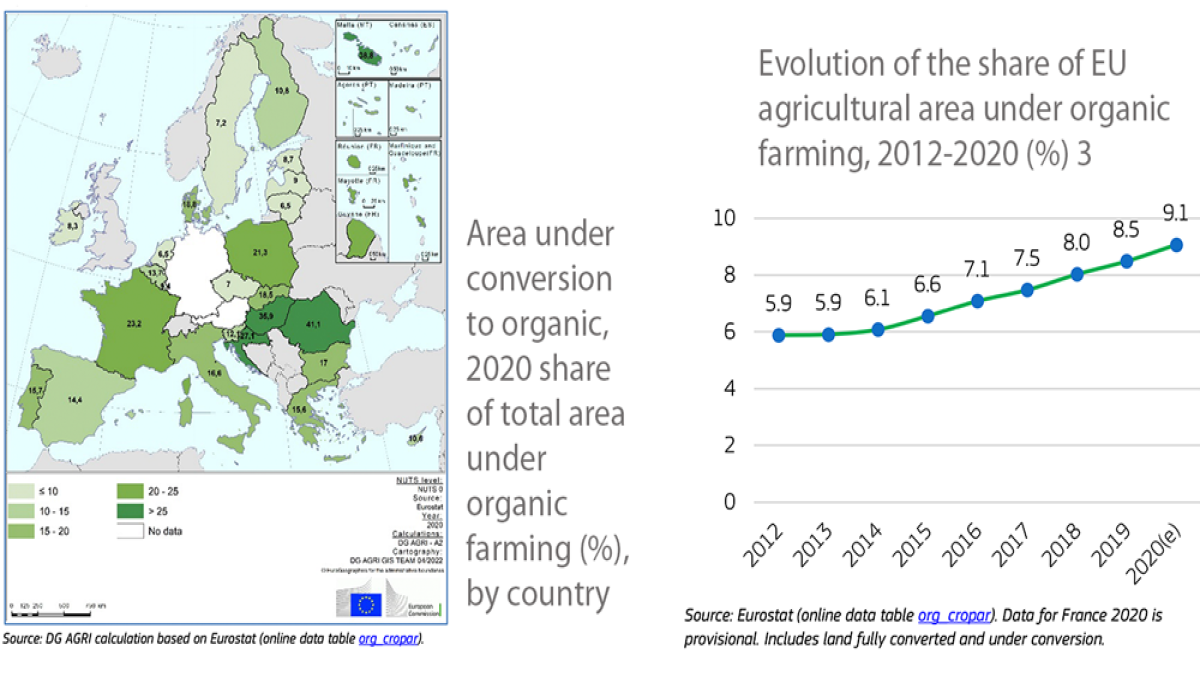
Image source: Content is owned by the EU on the European Commission website and is licensed under the Creative Commons Attribution 4.0 International (CC BY 4.0) license.
The European Union has been actively supporting organic farming due to its recognized benefits for sustainability, food quality, and consumers. This support has been extended from 2014 to 2022, with continuation in the 2023-2027 plans2. Financial assistance for this transition is provided through the European Agricultural Fund for Rural Development (EAFRD) and the European Agricultural Guarantee Fund (EAGF). These funds play a pivotal role in facilitating the transition to organic farming, covering various aspects like the adoption of organic fertilizers and ongoing organic practices. By 2020, these measures had encompassed 2.2% of the total agricultural land [Ibid].
As Europe embarks on the journey towards organic farming, it faces a spectrum of challenges that differ significantly across countries. These variations are driven by multifaceted factors, including disparities in financial resources, mature markets, and advanced infrastructure within wealthier nations. Conversely, less prosperous countries contend with weaker agricultural infrastructure, limited financial support, and nascent organic markets, perpetuating inequality in sustainable agriculture.
This landscape tends to favor larger agricultural interests, potentially marginalizing smaller, struggling farming communities. The European Union's goal of promoting organic farming, while undoubtedly beneficial for environmental sustainability and consumer health, inadvertently exacerbates inequality between Western Europe and Southern/Eastern Europe. Western European countries have historically had greater resources, infrastructure, and access to markets for organic products, allowing them to invest more heavily in organic agriculture. Meanwhile, Southern and Eastern European nations, facing economic disparities and structural challenges, struggle to keep pace.
In conclusion, the growth of organic farming in the EU presents both promise and challenges. To truly harness the potential of organic farming as a sustainable agricultural practice, it's imperative to address the valid concerns regarding inconsistent practices within the organic industry. Not all organic farming is inherently sustainable, and 'organic' can sometimes be used as a marketing term without ensuring genuine sustainability. As Europe continues its journey towards organic agriculture, it must prioritize practices that genuinely prioritize sustainability, equity, and long-term environmental health. Achieving these goals will require not only financial support but also comprehensive education and collaboration across all segments of the agricultural sector.
Meier, M., Stoessel, F., Jungbluth, N., Juraske, R., Schader, C., & Stolze, M. (2015). Environmental impacts of organic and conventional agricultural products – Are the differences captured by life cycle assessment? Journal of Environmental Management, 149, 193–208. https://doi.org/10.1016/j.jenvman.2014.10.006
References
1 Organic crop area by agricultural production methods and crops. (2023). https://ec.europa.eu/eurostat. Retrieved August 19, 2023, from https://ec.europa.eu/eurostat/databrowser/view/ORG_CROPAR/default/table?lang=en
2 Organic farming in the EU: a decade of growth. (2023, January 18). Agriculture and Rural Development. https://agriculture.ec.europa.eu/news/organic-farming-eu-decade-growth-2023-01-18_en
